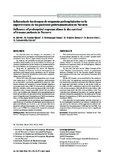Mostrar el registro sencillo del ítem
Influencia de los tiempos de respuesta prehospitalarios en la supervivencia de los pacientes politraumatizados en Navarra
| dc.creator | Ali Ali, Bismil | es_ES |
| dc.creator | Fortún Moral, Mariano | es_ES |
| dc.creator | Belzunegui Otano, Tomás | es_ES |
| dc.creator | Teijeira Álvarez, R. | es_ES |
| dc.creator | Reyero Díez, Diego | es_ES |
| dc.creator | Cabodevilla Górriz, A. | es_ES |
| dc.date.accessioned | 2018-03-05T09:38:13Z | |
| dc.date.available | 2018-03-05T09:38:13Z | |
| dc.date.issued | 2015 | |
| dc.identifier.issn | 0590-1871 (Print) | |
| dc.identifier.issn | 2530-5840 (Electronic) | |
| dc.identifier.uri | https://hdl.handle.net/2454/27628 | |
| dc.description.abstract | La relación entre los tiempos de respuesta y la mortalidad de los pacientes politraumatizados en la denominada “hora de oro” sigue siendo tema de debate. El objetivo del presente estudio es determinar las variables relacionadas con la mortalidad en dichos pacientes y la influencia de los tiempos de respuesta de los Servicios Médicos de Emergencia en dicha mortalidad. Para ello se analizaron los datos del Registro “Major Trauma de Navarra” (cohorte retrospectiva de pacientes politraumatizados atendidos por el sistema sanitario de Navarra) durante los cuatro años comprendidos entre 2010 y 2013. De los 217 casos de trauma disponibles para el análisis, fallecieron 42 (19%). En el análisis multivariante no se encontró asociación significativa entre los diferentes tiempos de respuesta y la mortalidad: llegada a la escena (odds ratio (OR) 1,0; intervalo de confianza al 95% (IC) de 0,99 a 1,01), en el escenario (OR 1,00; IC 95% de 0,98 a 1,02) y tiempo total (OR 1,00; IC 95% de 0,99 a 1,01). Las variables que influyen en la mortalidad son la edad del paciente y la gravedad de las lesiones medidas por el Triage-Revised Trauma Score (T-RTS) prehospitalario y el New Injury Severity Score (NISS). La mortalidad de los pacientes politraumatizados atendidos por el sistema de emergencias en nuestra región está influida por la edad, y por la intensidad de la agresión sufrida determinada por el T-RTS prehospitalario y por el NISS. Los tiempos de respuesta prehospitalarios no influyen significativamente. | es_ES |
| dc.description.abstract | The relation between response times and mortality of polytrauma patients in the so-called “golden hour” continues to be a subject of debate. The purpose of this study is to determine the variables related to mortality in these patients and the influence of response times of the Emergency Medical Services in this mortality. To this end, the data in the “Major Trauma of Navarre” Register (retrospective cohort of polytrauma patients attended to by the Navarre Health Service) were analyzed for the four year period between 2010 and 2013. Of the 217 trauma cases available for the analysis, 42 (19%) died. No significant association was found in the multivariate analysis between the different response times and mortality: arrival at the scene (odds ratio (OR) 1.0; 95% confidence interval (CI) from 0.99 to 1.01), in the scenario (OR 1.00; 95% CI from 0.98 to 1.02) and total time (OR 1.00; 95% CI from 0.99 to 1.01). The variables that influenced mortality are patient age and severity of injuries measured by the prehospital Triage- Revised Trauma Score (T-RTS) and the New Injury Severity Score (NISS). The mortality of polytrauma patients attended to by the emergency system in our region is influenced by age and by the intensity of the aggression suffered, determined by the prehospital T-RTS and by the NISS. The response times of the hospital do not have a significant influence. | en |
| dc.format.mimetype | application/pdf | en |
| dc.language.iso | spa | en |
| dc.publisher | Gobierno de Navarra | es_ES |
| dc.relation.ispartof | Anales del Sistema Sanitario de Navarra, 2015, 38(2), 283-292 | es_ES |
| dc.rights | Creative Commons Attribution-NonCommercial 4.0 International (CC BY-NC 4.0) | en |
| dc.rights.uri | http://creativecommons.org/licenses/by-nc/4.0/ | |
| dc.subject | Mortalidad del politraumatizado | es_ES |
| dc.subject | Hora de oro | es_ES |
| dc.subject | Tiempos de respuesta prehospitalarios | es_ES |
| dc.subject | Polytrauma mortality | en |
| dc.subject | Golden hour | en |
| dc.subject | Prehospital response times | en |
| dc.title | Influencia de los tiempos de respuesta prehospitalarios en la supervivencia de los pacientes politraumatizados en Navarra | es_ES |
| dc.title.alternative | Influence of prehospital response times in the survival of trauma patients in Navarre | en |
| dc.type | Artículo / Artikulua | es |
| dc.type | info:eu-repo/semantics/article | en |
| dc.contributor.department | Ciencias de la Salud | es_ES |
| dc.contributor.department | Osasun Zientziak | eu |
| dc.rights.accessRights | Acceso abierto / Sarbide irekia | es |
| dc.rights.accessRights | info:eu-repo/semantics/openAccess | en |
| dc.relation.publisherversion | https://doi.org/10.4321/s1137-66272015000200011 | |
| dc.type.version | Versión publicada / Argitaratu den bertsioa | es |
| dc.type.version | info:eu-repo/semantics/publishedVersion | en |



